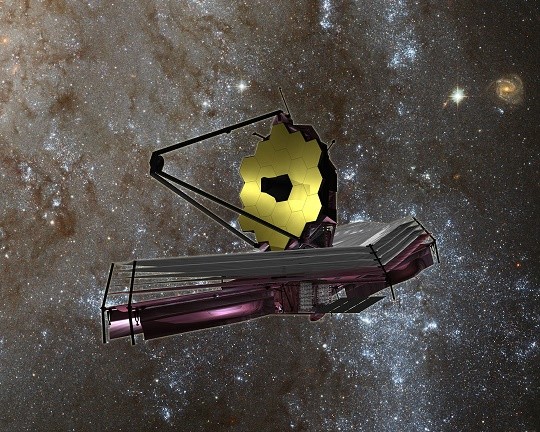Hubble's Successor, the James Webb Space Telescope, Launches in 2018
| Ana Verayo | | Apr 22, 2015 05:10 AM EDT |
(Photo : NASA) The James Webb Space Telescope is a large, infrared-optimized space telescope designed to be the premier observatory of the next decade, serving thousands of astronomers worldwide.
The magnificent Hubble Space Telescope celebrates 25 years in orbit and during that span has captured thousands of images, including iconic nebulae and galaxy-filled Ultra Deep Field photos that are great milestones in astronomy and physics.
The aging space telescope has its own limitations, however.
Like Us on Facebook
Beyond these galaxies thousands of light years away, Hubble's imaging capabilities draw a blank not because of the void in space but because Hubble can no longer detect light emissions from even more distant cosmic objects in the ultraviolet and infrared wavelengths.
In October 2018, Hubble will hand over the reins as humankind's eye on the Universe to its successor, the James Webb Space Telescope that will be capable of taking powerful infrared images.
There are other operational infrared space telescopes such as NASA's Spitzer and ESA's Herschel space observatories. What makes JWST different is the sheer size of its mirror whose far larger surface area means it can collect more light photons and therefore "see" more of the Universe in non-visible wavelengths.
Hubble has a 7.9 foot diameter mirror while Spitzer's mirror is 2.75 feet across. JWST's mirror, however, is an astonishing 21 feet in diameter.
JWST is slated to detect and see the first light emitting objects that emerged shortly after the Big Bang and will also function as a general purpose observatory like Hubble.
It can see infrared light invisible to the naked eye by sensing this light as heat. This allows JWST to penetrate through the obscuring dust that forms infant stars and protoplanets.
Astronomer Rupali Chandar from the University of Toledo believes there's a difference between old globular clusters of stars and younger ones described as open clusters. Hubble showed that this dicohotomy doesn't exist but JWST will now be able to "see" relatively near galaxy clusters along with those that formed during the universe's infancy.
Apart from infrared detections of extremely distant stars and galaxies, JWST will be able to detect chemicals found in the atmosphere of exoplanets that can provide clues about the existence of extraterrestrial life.
Webb can also observe planets passing in front of their parent stars, similar to NASA's Kepler telescope and Hubble, as well. When these exoplanets transit their host stars, astronomers using the JWST will be able to detect elements such as water, carbon dioxide and methane that are necessary for life.
TagsHubble's Successor: Powerful James Webb Space Telescope Launches in 2018, NASA, hubble, James Webb Space Telescope, Hubble Space Telescope
©2015 Chinatopix All rights reserved. Do not reproduce without permission
EDITOR'S PICKS
-

Did the Trump administration just announce plans for a trade war with ‘hostile’ China and Russia?
-

US Senate passes Taiwan travel bill slammed by China
-

As Yan Sihong’s family grieves, here are other Chinese students who went missing abroad. Some have never been found
-

Beijing blasts Western critics who ‘smear China’ with the term sharp power
-

China Envoy Seeks to Defuse Tensions With U.S. as a Trade War Brews
-

Singapore's Deputy PM Provides Bitcoin Vote of Confidence Amid China's Blanket Bans
-

China warns investors over risks in overseas virtual currency trading
-

Chinese government most trustworthy: survey
-

Kashima Antlers On Course For Back-To-Back Titles
MOST POPULAR
LATEST NEWS
Zhou Yongkang: China's Former Security Chief Sentenced to Life in Prison

China's former Chief of the Ministry of Public Security, Zhou Yongkang, has been given a life sentence after he was found guilty of abusing his office, bribery and deliberately ... Full Article
TRENDING STORY

China Pork Prices Expected to Stabilize As The Supplies Recover

Elephone P9000 Smartphone is now on Sale on Amazon India

There's a Big Chance Cliffhangers Won't Still Be Resolved When Grey's Anatomy Season 13 Returns

Supreme Court Ruled on Samsung vs Apple Dispute for Patent Infringement

Microsoft Surface Pro 5 Rumors and Release Date: What is the Latest?










